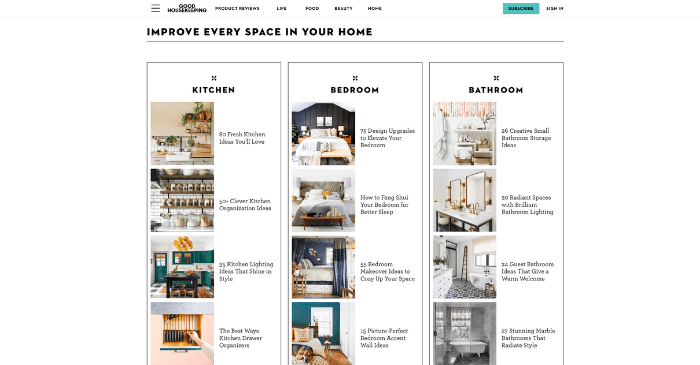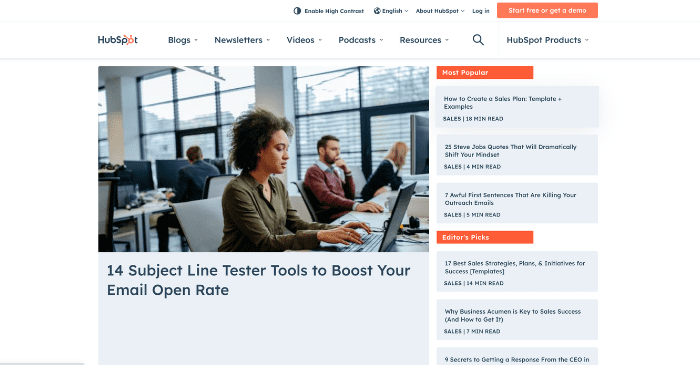If you’ve struggled to write effective marketing copy, we’ve got the copywriting tips you need.
Whether your digital marketing niche is website content, email marketing, or ad copy, fundamentally good copywriting skills will have a huge impact on your business. The better your copy, the higher your conversion rates, the more in-demand you become.
But where do you start?
Right here. We’ve compiled 25 copywriting tips from trusted experts, sure to make dull copy dazzle.
25 Timeless Copywriting Tips That’ll Transform Your Writing
Our featured writers have decades of experience in SEO copywriting and content marketing. For their efforts, they’ve earned millions of dollars for their clients. Their copywriting tips range from the power of storytelling to the effectiveness of sentences that run short, and sweet.
We’ll start with what to do before you begin, and end with writing powerful calls to action that will have potential customers saying Yes! to your offer.
Let’s go…
Strategy (Before You Begin)
1. Robert W. Bly: Know Your Goal
According to direct response copy legend Robert Bly, the first step to creating better copy is knowing your objective.
In other words, is your email copy, blog post, sales copy or any other content meant to:
- Generate leads?
- Ask the reader to make a purchase?
- Draw traffic to your website?
- Warm up a cold audience?
- Build brand recognition?
Your objective is the goal you’ll be targeting as you write. And everything in your copy should point in that direction.
2. Ashlyn Carter: Build Swipe Files
Swipe files are pieces of compelling copy we collect to inspire our work. And conversion copywriter Ashlyn Carter is a big proponent of building three different swipe files:
- Traditional Swipe File – email and website copy, a compelling direct mailer or Facebook ad — any piece of good copy you want to emulate.
- Story Banking – stories and observations from your life. These work great in blog posts and other copy for illustrating your point.
- Copy Banking – words, phrases, quotes that resonate, that you’ll sprinkle throughout your copy.
Whether ‘stolen’ from others, or all your own, swipe files work.
Use them!
3. Robert W. Bly: Research, Research, Research!
You can’t write great copy if you don’t thoroughly understand your topic.
That means research. And whether your client is a small business or large, Bly suggests your client already has what you need to kickstart your brand awareness, including:
- Sales brochures
- White papers
- Articles and blog posts
- Press releases
- Speeches
- Testimonials
But don’t stop there. Learn more about your competition. Interview people. Get deep into your subject and know it well.
The strength of your copy rests on how well you know your subject.
4. Joyce Carol Oates: Lose the World, Find Your Focus
Best-selling author Joyce Carol Oates cautions you to avoid distractions when you’re writing.
- Keep your phone out of reach.
- Turn off your television.
- And close the other tabs in your browser.
Find a quiet space of your own, where you can work undisturbed. It might mean getting up at 5 a.m., or staying up late, but you’ll do your best work when it’s silent and your focus is on nothing but your words.
5. Joanna Wiebe: Follow a Formula
Copyhackers founder Joanna Wiebe says, “Only rookies write from scratch.”
Writing effective copy is so much easier when you have a formula to follow. And examples of great writing formulas abound, including:
- Headline formulas
- Email templates
- Sales letters
And, there’s a plethora of great copywriting swipe files at your fingertips thanks to Google. Be it a product description, meta description, or any other form of content writing, someone has created a free resource to make you better. You’ll save time, and, you’ll be learning by example.
Stumbling around in the dark is for rookies.
6. Ann Handley: Pay Attention
Ann Handley is a contemporary content-writing legend. Her tip for writing success? Pay attention to what’s happening around you:
- Watch the interactions between people at the grocery store.
- What did you see in the pickup line at school?
- What conversations caught your eye in that Facebook group?
Our observations of the world around us can come together to create stories. Not just that, they’re clever ways to:
- Illustrate ideas in your writing.
- Add life to your copy
- Give readers something they can relate to.
And, they’re free. So keep our eyes open.
The Headline
7. David Ogilvy: Make the Reader a Promise
The famed master of ad copy David Ogilvy wants you to make the reader a promise.
A promise grabs the reader’s attention. It draws them in, it creates curiosity, it motivates them to read further.
But be specific in what your headline promises, or you’ll create confusion instead of curiosity. And make sure your copy keeps that promise. If you promise to double your reader’s gas mileage, your copy has to show them how. Or, you’ll lose your reader and the opportunity for conversion.
8. Michael Masterson: Capture Your Target Reader With the 4 U’s
Copywriter and entrepreneur Mark Ford (aka Michael Masterson) developed the 4U formula for crafting headlines. Powerful headlines, according to Ford, must be:
- Urgent – the fear of loss or missing out must prompt people to keep reading.
- Unique – your offering must be unique or exceptional — a way for the reader to stand out amongst others.
- Useful – your headline must promise a solution to the reader.
- Ultra-specific – your headline (and its language) must target a very specific audience.
You may not hit every one of the 4 U’s when writing, but three out of four is still a good benchmark.
9. Gary Bencivenga: Be Clear, Not Clever
Gary Bencivenga, considered by some as America’s best copywriter, has this headline advice:
You might be tempted to show off and write something clever. Don’t give in to your ego. Communicate clearly what your article is about.
Look at this headline, courtesy of StudyLib:
New York Jets Run Out of Fuel
It’s clever, and if it’s in the sports section, you probably know it’s referencing the NFL team. But out of context, it’s not a clear headline and that could cause a lot of confusion for readers.
Especially if they have travel plans.
10. Jeff Goins: Use Numbers
Bestselling author and podcaster Jeff Goins suggests using numbers in your headlines. They grab eyes and make people pay attention.
Check out this example from Good Housekeeping’s home page:

Of the twelve articles featured, ten have numbers in the headline.
Or this, from HubSpot’s sales blog:

Five of the seven visible titles have numbers.
You may not be able to work numbers into every headline, but when you can, use them!
11. Ray Edwards: Call Out Your Audience
Ray Edwards, a communications strategist and author of How to Write Copy That Sells, says:
Use words that speak to the audience you want to reach.
If you’re selling self-publishing courses to aspiring authors, use author in your headline.
For example:
✅ How To Hit The Amazon Best-Sellers List: 5 Tips Every Author Needs to Know
is clearer than…
❌ How to Hit the Amazon Best-Sellers List: 5 Tips You Need to Know
Why? Well, who is the second article targeting? Resellers? Clothing retailers? Electronics retailers? There’s no way to know unless you add a word that identifies your target audience.
In the world of copywriting, specificity rules!
The Lead
12. John Caples: Tell a Story
John Caples is the creator of the famous ad headline:
They Laughed When I Sat Down At The Piano-But When I Started To Play!
The legendary ad begins with a story- a man sits down to the piano at a social gathering, his friends start laughing because they know he can’t play.
But, surprise, he’s good. Very good. And they all want to know how he did it.
Opening with an emotionally charged story is one of the foundational best practices of great ad copy. The reader is immediately hooked, because they want to know more. And, they want the same thing to happen to them.
13. Steve Slaunwhite: Lead With Your Most Important Point
The words of B2B copywriter and trainer Steve Slaunwhite, on why he’s such a fan of opening with your strongest point.
Leading with your strength hooks the reader from the start, addressing what they care about most. If you open with a supporting point, and your copy isn’t compelling, they’ll never read far enough to get to your message.
14. Steve Slaunwhite: Lead With a Statistic
Steve Slaunwhite also likes to lead his copy with an attention-grabbing statistic.
Like this one:
Did you know it’s easier to get into Harvard than to get a job at Walmart?
That grabs your attention, doesn’t it? It’s an unlikely-sounding statement. So you keep reading to find out more.
Sites like Statista or Statistic Brain, and even your own research, are great sources of attention-grabbing stats. Just remember to keep them relevant, verifiable, and out of clickbait territory.
15. Joseph Sugarman: Create a Mood
Famed copywriter Joseph Sugarman thinks your copy should create the mood for what you’re selling.
If you’re writing copy for a high-end product, you’ll use a tone that appeals to luxury buyers. Conversely, your copy will read radically different if you’re writing to the stay-at-home mom who lives on a budget.
A good copywriter sets the mood right from the start. She speaks her audience’s language, and matches her copy to where her potential customers are in their life.
Make your reader feel comfortable and understood, and they’ll trust you.
The Body Copy
16. Richard Bayan: Specific Is Better
Richard Bayan is a copy chief and author of the best-selling book, Words That Sell. His advice for writing better persuasive copy?
Be very specific.
Specificity makes your message effective because it creates a vivid image. For example, which of the following creates the more evocative imagery?
❌ Steak and potatoes?
or
✅ Herb-Crusted Fillet Mignon with Garlic Thyme Fondant Potatoes?
The first sounds good, but the second has me drooling.
17. Henneke Duistermaat: Use Bullet Points
The author of How to Write Seductive Web Copy, Henneke wants you to stop writing sleep-inducing paragraphs. Your copy should be easy to read, and bullets are a great way to accomplish that.
Bullet points break the monotony of long blocks of text. They’re like signposts that make navigating your content quick and efficient, and they work especially well with:
- Numbered steps
- Benefits
- Features
Make your bullet points short and punchy, and stick to one idea per bullet point.
18. Laura Belgray: Write In the Second Person
Acclaimed email marketer Laura Belgray suggests personalizing your copy. When you write like you’re speaking to one person, it pulls the reader into the story. And that will give them a better taste of what your product or service is about.
How do you do that?
Use the word you.
For example:
✅ The moment you step into our luxury hotel suite, Jennifer, you’ll feel ready to relax with your personalized spa services.
speaks far more effectively than…
❌ Our customers say our luxury hotel suites help them relax and enjoy their spa treatments.
Make it personal, make it about You.
19. Heather Lloyd Martin: Use Relevant Language
SEO copywriter and search engine expert Heather Lloyd Martin says keep your copy fresh and relevant.
If you’re using outdated language, or clichés, your audience will notice. This is critical in rapidly-changing fields like technology or social media, where staying up-to-date is an ongoing challenge.
If you want your readers to stay with you, you need to be with it. Stay current, and you’ll remain relevant.
20. Carline Anglade-Cole: Ask Yes! Questions
Award-winning copywriter Carline Anglade-Cole thinks there’s power in Yes.
The goal of any copywriter, Carline says, is an enthusiastic Yes to your call to action. And you’ll increase your odds when you give them opportunities to say yes while they’re reading. For example:
Have you ever been on a tight deadline? And you’ve run into writer’s block? Your stomach drops, your chest tightens. You panic. You sweat. You’ll never finish in time.
Every writer who’s been up against a deadline is nodding yes! Get them saying Yes as they read, and it’s an easier Yes at the CTA.
The Call to Action
21. Shanna Mallon: Use Social Proof
What is social proof? It’s the idea that people are more likely to buy when others already have. And freelance blogger and copywriter extraordinaire Shanna Mallon wants you to use it.
Working social proof into your call to action can tip the scales in your favor with hesitant buyers. When readers know that others have taken the same risk they’re being asked to, they’ll feel more comfortable about making a purchase.
For example:

Tiago Forte says you’ll be in good company with 50,000+ others who have already signed up for his weekly newsletter. And 50,000 others can’t all be wrong, can they?
22. Brad Shor: Test Your Assumptions
Brad Shor, Director of Content Strategy at Straight North, thinks you should stop assuming.
It’s easy to fall into comfortable habits as you gain experience as a copywriter. But you need to test your assumptions about what works. Just because everyone’s saying “Get your free download now” has the best conversion rates, it doesn’t mean it’s true.
Test your copy, and know definitively which words in your CTAs work best for your particular audience.
23. Julia McCoy: Make It Pop
Julia McCoy, Founder of Content Hacker, believes your CTA should make the kind of statement that excites readers.
Splashy headlines, unique benefits, enticing offers — they’re all great ways to inspire action. But, use power words in your CTA, and give specific reasons why your readers should act now?
Now you’ve got Pop!
Which of the following gets more clicks?
❌ Download this free ebook on aging.
or
✅ Grab your report and learn how to stop aging in its tracks!
Power word, offer, (very) unique benefit, specific ask. All there.
Your CTA is your last shot with your reader. Make sure it pops.
24. Daniel Doan: Make It Relatable
Conversion expert Daniel Doan says your CTA must drive your product’s benefit home. You can do that by making sure your call to action addresses a pain your reader relates to.
Which of the following CTAs would you relate to?
❌ Buy my book?
or
✅ Learn how to manage your money and become a millionaire?
People buy because they need to solve problems. Or make life better. When you paint a picture they’ll relate to, you’re putting them on track to getting there.
25. Kate Sitarz: Stop Using Click Here
People use voice commands. They tap. They swipe left, and right. And wildly effective copywriter Kate Sitarz thinks click here is outdated.
Use a phrase that describes the specific action you want your reader to take, Kate says. Something like:
✅ Start your meal subscription now.
or
✅ Build your budget spreadsheet tonight!
Lose the click now and swap it out for action-specific alternatives, and your readers will be crystal-clear on what you want them to do. And, the benefit they’ll get from your offer.
Which Copywriting Tip Will You Try First?
You’ll shorten your learning curve (and maybe even avoid writer’s block) with these 25 expert-proven copywriting tips. From headline through call to action, you’ll engage your readers more effectively, and your copy will be more persuasive.
Look, you spend a lot of time on your content. But the investment is worth it only if your copy captures your audience’s attention, and carries them all the way through your message.
These copywriting tips will make the difference.
Which one will you try first?






One of the best articles on Copywriting I have read so far. Comprehensive, easy to digest, practical points, no fluff, every single concept makes sense. Good job Jennifer! Looking forward to reading more blog posts!
Jennifer – you had me at, ’25 Actionable Copywriting Tips That Make Dull Copy Dazzle’
Thank you.
Re: #25: I like and use many alternatives to click-here, including download, claim, grab, start, and a personal favorite for subscriptions and services, activate. But I also use click-here, too.